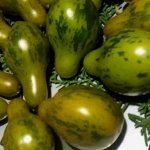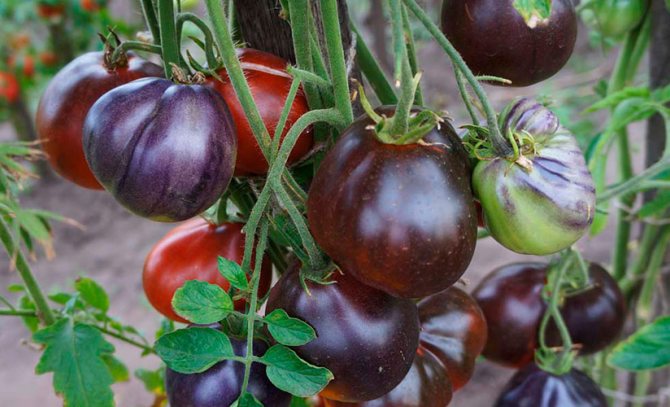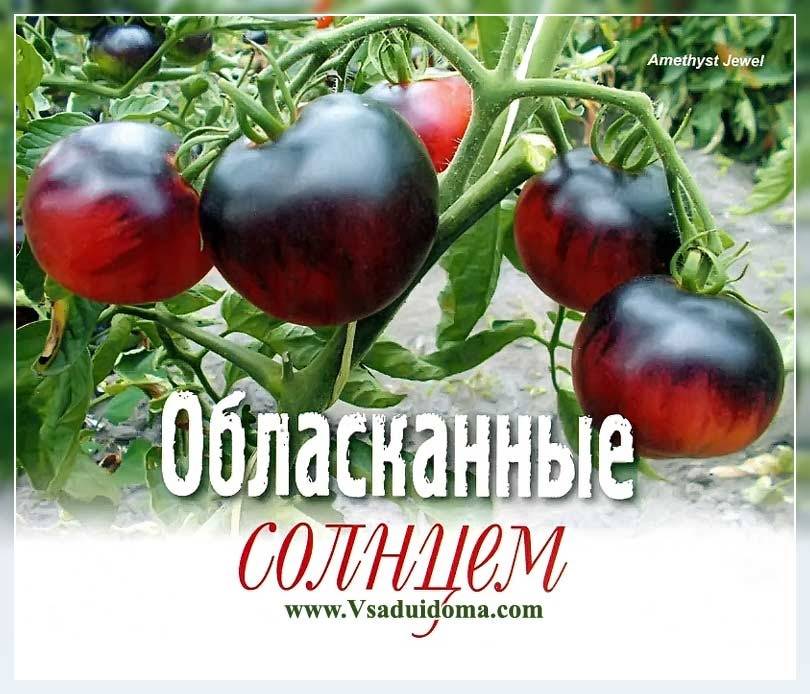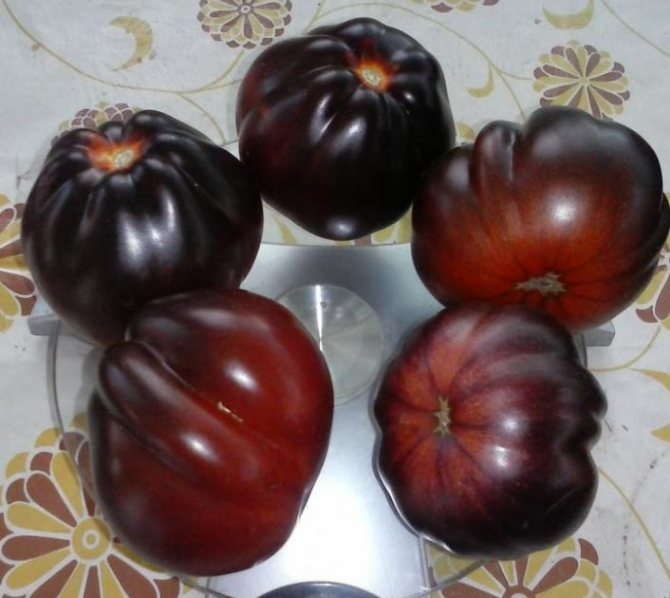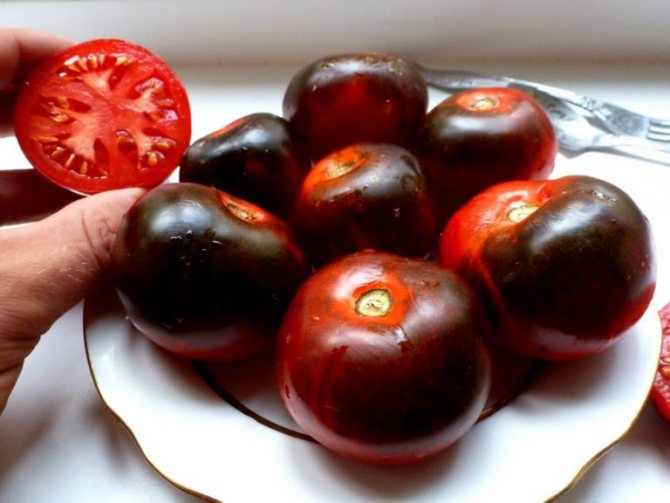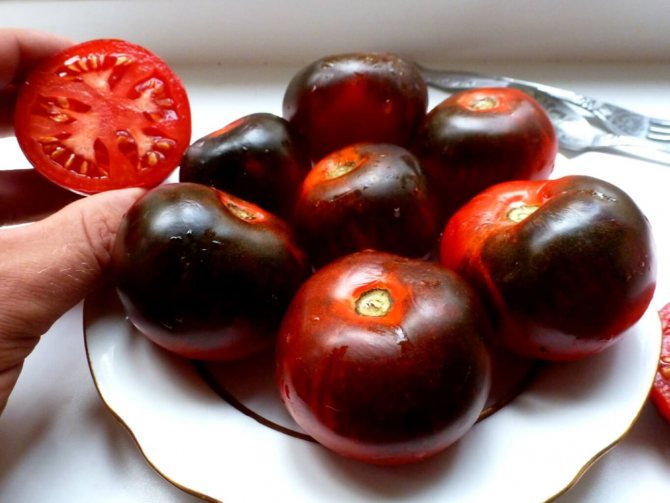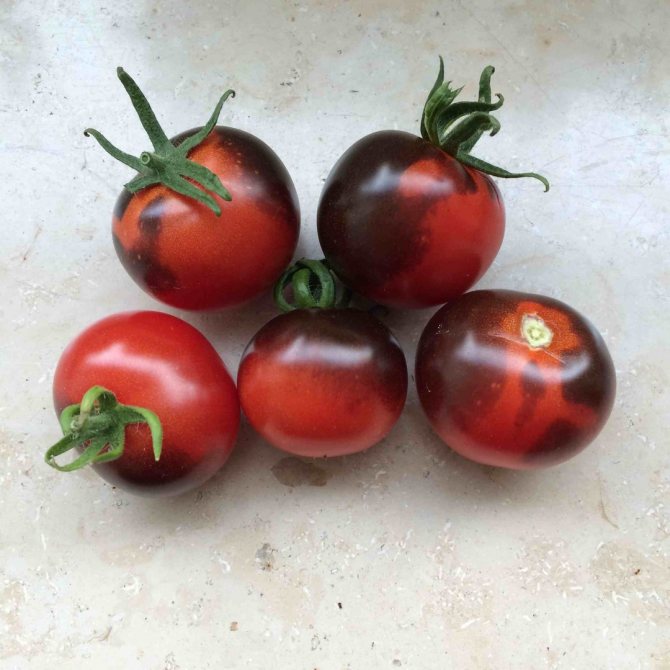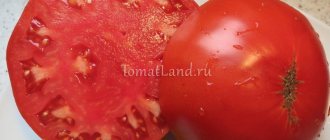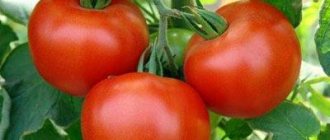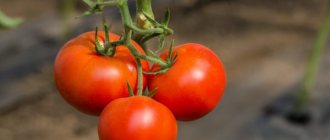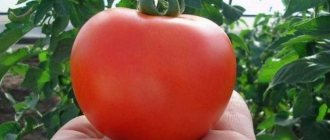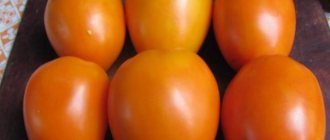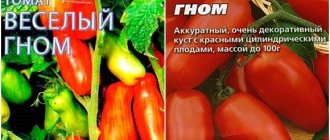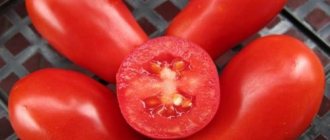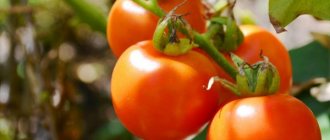Tomato Blue Pear will appeal not only to lovers of unusual varieties, but also to all gardeners. Belongs to the selection of Ruslan Dukhov, intended for open and closed areas.
| Height | Pick-up location | Ripening terms | Fruit color | Fruit size | Origin | Fruit shape |
| Tall | Greenhouse, Open ground | Mid-season | Purple | Middle | Variety | Pear-shaped |
Advantages and disadvantages of a colorful vegetable
Pros:
- marketable condition;
- yield;
- endurance of adverse factors;
- excellent heat and drought tolerance;
- excellent taste.
Minuses:
- the importance of pinning and shaping.
Tomato has a number of advantages:
- The tomato attracts with its appearance and taste.
- Tomato products are made from the fruits, they are eaten fresh.
- The yield of 1 bush can reach 4.5 kg.
- The tomato is characterized by resistance to cold weather and hot weather.
- Tomatoes are not prone to cracking.
- The culture is insensitive to the lack of lighting.
The disadvantages are:
- the need for regular pinching;
- deepening of ribbing with improper care.
Tomatoes in a nutshell Almost blue blood
The average weight of a tomato is 150-200 grams. At the time of flowering, it is light green in color, and when the fruit is ripe, it is blue or dark blue. At the same time, the pulp of the tomato is bright red. By itself, the "vegetable" is quite sweet and is in perfect harmony with many seafood.

The bush grows up to 2 meters high. On average, the plant grows up to 5-6 tomatoes on one brush.
In terms of taste, they are suitable for combination with fish or other seafood. The flesh of tomatoes is fleshy, has a fruity tint, while the peel is rather soft.
Growing rules
To plant a tomato, the following rules must be observed:
- Planting is done on the sunny side of the site.
- Carry out regular watering. Sometimes each bush requires up to 15 liters per week.
- Do not pluck the fruits prematurely. Nutrient availability will be below normal.
- Fertilize seedlings at an early stage of growth and after planting in the ground.
- For 1 sq. m planted in 4-5 bushes.
- They tie up in time.
- Bushes are regularly huddled to supply oxygen to the soil.
Planting seedlings
It is necessary to prepare the soil for planting in the fall. The soil is saturated with oxygen, left in a cold place until the beginning of spring. During the winter, the earth will freeze, there will be no larvae that eat tomato seeds. At the time of planting, the soil is mixed with mineral fertilizers, compost, sand, humus. You can also purchase quality soil at any hardware store.
Any container is suitable for seedlings: pots, boxes, trays with individual compartments for each seed. The container is washed, disinfected with a solution of diluted potassium permanganate, rinsed and left to dry.
Seeds can be bought new or used from a previous planting. First, the seeds are tested for germination. To identify the pacifiers, the seeds are immersed in water for 10 minutes, the pacifiers will float to the surface. You need to germinate seeds at room temperature, in a dampened cotton cloth. Add water daily. On the 5-6th day, the seeds are planted in the ground.
The first shoots appear in 3-4 days. It is necessary to control the moisture content of the soil, an excess of water will kill crops.The seedlings are ready for picking when they grow 7-10 cm, when 2-3 true leaves are fully formed. Plastic cups are suitable for individual containers. The stem of the seedling is buried before the leaves begin to grow. Then the seedlings are watered every 2-3 days.
Tomato transplant
Transfer to the beds is carried out at a constant temperature of 15 to 18 ° C. They make beds, fertilize with compost or manure. Tomatoes are ready for planting with a growth of 15-20 cm. The planting is done at a depth of 10-15 cm so that the stem is at a right angle. The distance between the bushes is up to 50 cm. After planting, the seedlings are watered.
A drip irrigation system is installed in the greenhouse, it can be automated. Top dressing is done once a week, with a good microclimate, once every 2 weeks. Mulch with stagnant soil at the roots of tomatoes.
Pinning algorithm:
- Disinfect inventory: garden shears, pruning shears. You can use regular scissors.
- At a distance of 1 cm from the base of the stem, stepchildren are cut at a right angle.
- After cutting the stepsons from one bush, the tool is disinfected.
Tomatoes are tied up with a growth of 60-70 cm. The bushes at this moment begin to creep along the ground, the ovary of flowers is visible. The garter allows natural light to flow openly. Tied to a peg, net or make a frame with a garter on ropes.
Pest and disease control
Due to the lack of calcium and magnesium in the soil, the variety affects the top or white rot. Greenhouse tomatoes are often infected with white rot due to their proximity to other vegetable crops. When the first signs of the disease appear, rotten shoots are destroyed, sometimes the whole bush is disposed of.
From fungal and viral diseases at the beginning of growth, tomatoes are treated with a solution of potassium permanganate with potassium. From the Colorado potato beetle in a greenhouse and in an open area, the bushes are treated with a standard solution of toxic chemicals. From slugs, caterpillars and other creeping pests, the roots of the bushes are sprinkled with copper sulfate. Chemical treatment is carried out at the beginning of the growth of the bushes, then once a month.
The origin of the yellow pear tomato variety
| Variety name | Pear Red |
| general description | Mid-season indeterminate hybrid |
| Originator | Russia |
| Ripening period | about 100 days |
| The form | Pear-shaped |
| Color | Red |
| Average weight of tomatoes | 50-75 grams |
| Application | For processing and conservation |
| Variety yield | 2.2 kg per bush |
| Growing features | Standard agricultural technology |
| Disease resistance | We need prevention against fungal diseases |
Varietal tomato Pear Red - an indeterminate variety of medium ripening terms. The bush is stemless, medium leafy, with a height of 120 to 160 cm. The variety was bred by Russian breeders in 1998, registered in 2004.
With regard to the cultivation method, the variety belongs to the universal subspecies. It grows and bears fruit equally well in open beds and in a greenhouse. "Red Pear" has an average resistance to diseases and pests.
The Red Pear tomato variety is high-yielding. From tomatoes grown in a greenhouse, subject to agricultural technology, you can collect at least 2.2 kg of fruits from one plant. In open beds, this figure usually does not exceed 1.8 kg per bush.
Advantages and disadvantages:
- Pros: unsurpassed yield and uniformity of fruits, which also differ in excellent taste.
- Cons: the need for constant formation of the bush and tying it up.
Red pear, unlike varieties similar to it in shape and other characteristics, is grown in two stems. It is with this formation of the bush that you can get more marketable fruits from it.
Read on our website: how to get
good harvests of tomatoes in the open field
and
winter greenhouses
.
What are the subtleties of growing early varieties of tomatoes that every gardener needs to know? Which tomato varieties are resistant to most diseases and high yields?
The variety "Yellow Pear" (original name "Yellowpear") was bred in Holland. It was entered into the State Register of Russia in 2001. Tomato is one of the Pear varieties, along with red, black, pink, orange and emerald varieties.
Description and characteristics of the variety
The blue pear is an indeterminate tall variety, the bushes reach a height of 1.5 m, in a greenhouse up to 1.8 m. They require garters and shaping.
Best results can be achieved with 2 shoots.
Ripening periods are average - 110-125 days from germination.
The average weight of tomatoes is 100-150 g. The skin is purple. The flesh on the break is fleshy, red in color.
Tomatoes: advantages and disadvantages
"Yellow Pear" has the following advantages:
- Excellent seed germination;
- High productivity;
- Great taste;
- The original exterior of the fruit;
- Resistant to most diseases of nightshade crops, as well as to fruit cracking;
- Long-term preservation;
- Transportability over any distance.
The variety also has its disadvantages:
- Demanding agrotechnics and soil composition;
- Poor draft tolerance.
How to understand that an almost blue blood tomato is already ripe
In this matter, it is worth relying on color. During ripening, the fruit changes its color from light green to yellow. With abundant sun and watering, over time, it changes to dark blue.
The fact that the fruits are already ripe can be recognized by the structure of the fruit itself. In most cases, the shape of a ripe tomato has an ideal shape, slightly "flattened" on top. However, there are cases when there is no sign of "flattening". In such cases, you can determine the diameter of the fetus itself. As a rule, a ripe fruit has a diameter of 8-10 cm.
You can buy a tomato Almost blue blood from us. There is no need to fear for the germination of seeds, because they are all stored in ideal climatic conditions corresponding to this type of product. Moreover, the seeds are packed in special moisture-resistant packages that protect them from foreign impurities and insects. More detailed information about the cost and packaging can be found on the website.
Fruit application
The greatest benefit "Yellow Pear" can bring when consumed fresh. In addition to the appetizing appearance and exquisite aroma, the fruits have a large number of useful substances:
- Vitamins A, B, C;
- Trace elements: calcium, phosphorus, magnesium, iron, potassium;
- Folic and other organic acids;
- Myocin, which strengthens the walls of blood vessels, and is found exclusively in yellow tomatoes.
"Yellow Pear" is indicated for use by people suffering from diseases of the gastrointestinal tract, as well as allergy sufferers. The compact size of tomatoes makes it possible to preserve them both processed and whole. The dense skin withstands heat treatment and retains the presentation of the fruit even a year after conservation.
At the moment, thanks to the work of breeders, the Pear series includes six varieties: Yellow, Orange, Black, Red, Pink and Emerald. Everyone except the last variety is very popular among summer residents. Due to the unusual color of the fruits, this tomato has not yet won the recognition of gardeners, therefore, there are no reviews about its taste and characteristics of plants yet.
Important! The shelf life of tomatoes in a cool, dark place (including in the refrigerator) is 35-45 days.
The name of the variety determines the color of the tomatoes. But besides the rich color palette of fruits, there are other differences.
| Pink pear | Red pear | Black pear | Orange pear | Yellow pear | |
| Plant height | 170-200 cm | 120-160 cm | 160-180 cm | 150-170 cm | More than 2 meters |
| Ripening period | Early | Mid-early | Mid-early | Early | Early |
| Fruit color | Pink | Classic red | Maroon to brown | Bright orange | yellow |
| Ovary formation | Brushes 4-6 pcs | Brushes 5-8 pcs | Brushes 5-8 pcs | Brushes 5-8 pcs | Brushes 5-7 pcs |
| Planting scheme, pcs per 1 m² | 3-4 | 3-4 | 3-4 | 3-4 | 3-4 |
| Taste qualities | Sweet | Sweet, slightly sour | Very sweet | Sweet with a slight sourness | Sweet |
| Skin | Dense | Dense | Dense | Dense | Dense |
| Productivity from 1 m² | 6-8 kg and more | More than 6-8 kg | 10-12 kg | 10-11 kg | |
| Average fruit weight | 40-50 grams | 45 - 65 grams | 55-80 grams | 60-80 grams |
It is worth noting that from the whole series of pear-shaped tomatoes, the fruits of the "Black Pear" are distinguished by their taste. But "Orange" - easily tolerates heat and slight drops in temperature, and can also be stored for a long time without loss of taste and presentation.
All fruits of representatives of this series are distinguished by good keeping quality, pulp density, a small number of seeds and the absence of voids.
Thanks to these advantages, pear tomatoes are truly unique. For this reason, they are very popular among summer residents.
The field of application of a series of varieties of tomatoes "Pear" is very extensive.
Due to their unusual shape, small size and dense skin, tomatoes are excellent for whole-fruit canning. Tomatoes of different colors will look beautiful in a jar.
Important! To get a bountiful harvest, you need to form a bush in two stems in time and pinch the top after the formation of 7 or 8 full-fledged brush.
Tomatoes "Pear" of any kind are actively used in the preparation of preparations for the winter as a component of all kinds of salads, lecho, ketchup. Tomato juices are very thick and rich. Red tomato paste will be thicker due to its firm pulp and high solids content.
Due to the unusual shape of tomatoes, the surface attachment of the stalk is the reason for the reduction of waste during cooking. Tomatoes of the Pear series are used in food and fresh, as well as slicing, for preparing fresh salads, decorating ready-made dishes.
The tomato has also found wide application in the preparation of second courses, in baking various casseroles and pizzas, baking in general and stuffed. Perfectly retains flavor and aroma when frozen and dried.
conclusions
Purple tomatoes look attractive and unusual. Varieties of violet-black color are distinguished by a high content of nutrients, resistance to the most common diseases, as well as high yields and a long fruiting period. As a result of long-term experiments, it has been proven that the use of these varieties of tomatoes has a beneficial effect on the human body affected by oncological diseases.
Some people think that the unusual color of the fruit is the result of genetic modification, but the varieties were developed through conventional breeding. Many forums write that tomatoes, when grown, did not turn purple, but remained pink or red. This fact is due to improper care. The purple color is provided by anthocyanins, the amount of which decreases if the soil is insufficiently fertilized, and the acid-base balance is reduced.
In general, nothing bad can be said about the varieties. All around there are only pluses. Often tomatoes of purple varieties are grown for decorative and aesthetic purposes in greenhouses and apartments.
Bush care
The agrotechnology of growing "Yellow Pear" does not differ from that of other indeterminate varieties:
- Tying the stems to the greenhouse frame or trellises;
- Pickling in 1-2 stems and pinching of growth shoots at the stage of blanche maturity;
- Watering with settled warm water 2-3 times a week;
- Loosening the soil between waterings;
- Mulching the ground to keep moisture in the ground;
- Top dressing with NPK complexes every 14 days.
Michael Pollan
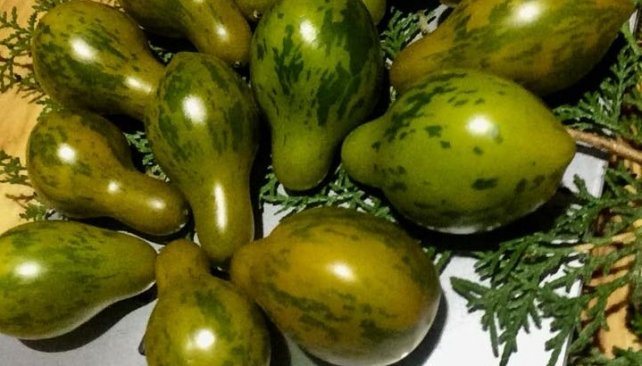

Photo by Inna Biryuk


Photo Vasara Vasara and Olga Musina
So we got to the last place in our TOP. However, we want to say right away that the latter does not mean bad, because they chose the best of the best! So, 7th place went to a variety with a foreign name - Michael Pollan (original name Michael Pollan). What are these tomatoes good for?
The variety is indeterminate, but, in comparison with other similar varieties, it is not very high - up to 1.2 m. However, you cannot do without a garter. The fruits are collected in clusters, each of which may contain 30 or more tomatoes. For this reason, a mandatory garter is required not only on the stem, but also on the brushes. They need to be fixed in several places so that they do not break from their own weight.
The fruits are beautifully pear-shaped. They are green (green-yellow when ripe) with green stripes. Tomatoes are small: the weight of each does not exceed 80-100 g. The taste is unusual, with fruity notes. Tomatoes of this variety are suitable for salads and canning.
Feedback from our readers about the variety Michael Pollan
Olga Musina: "The fruits are tight, juicy, sweet."
Ekaterina Golovinova: “I like the fact that it grows with brushes up to 100 pieces. In comparison with large fruits, in salads so-so, but absolutely incomparable in pickled form. He has a thin skin, does not come off; you can say you don’t feel it. Absorbs what you wanted to give him with the marinade, without interrupting your taste. I marinate in honey and apple cider vinegar. Sometimes without vinegar, in apple juice. It's just a masterpiece, really! "
Not all tomato lovers know yet that a green tomato does not always mean unripe. We hope that after the feedback from our readers, you will also be interested in unusual green-fruited tomatoes, and our TOP-7 will help you choose the best variety.
Diseases and pests
"Yellow pear" will not cause much trouble to the gardener, as it has an innate resistance to the main diseases of tomatoes:
- Late blight;
- Fomoz;
- Tobacco mosaic.
Diseases affecting the Red Pear tomato are most often of a mushroom nature. To avoid their appearance, it is recommended to ventilate the greenhouse and spray the plantings with Bordeaux mixture from mid-July.
Tomato "Red Pear" is an excellent vegetable for growing on a personal plot. The hours spent in caring for the plantings will pay off a hundredfold in tens of kilograms of high-quality tasty fruits.
If you find an error, please select a piece of text and press Ctrl Enter.

